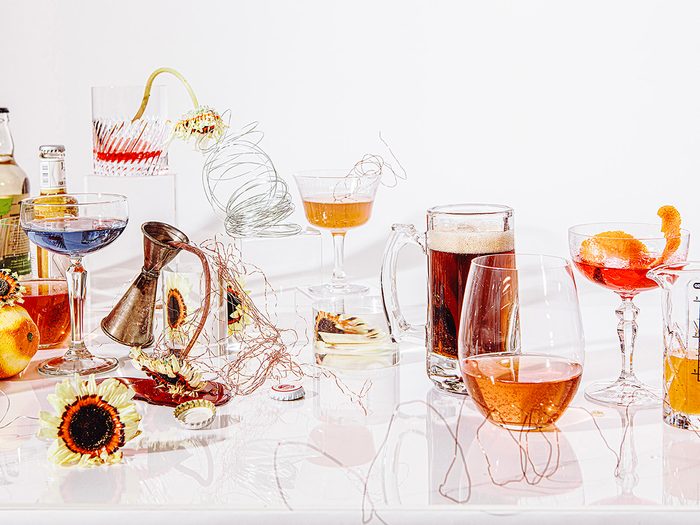A Science-Backed, Data-Forward, Awfully Sobering Guide for Women Who Drink Alcohol

That small glass of red wine we've loved to have with dinner is no longer considered "healthy." And it gets worse...
Two drinks per week. That’s the maximum number that the Canadian Centre on Substance Use and Addiction now recommends adults consume to avoid “negative alcohol consequences.” And by consequences, they do not mean merely hangovers. It’s actually extremely dire: Drink and your risk for developing all kinds of cancers (head and neck, stomach, pancreatic, liver, colorectal and, most significantly for women, breast) increases, as does your risk for heart disease and liver cirrhosis.
But hold on. Let that sink in. Two drinks. Per week. In 2011, the guidelines for low-risk drinking allowed 10 drinks total per week for women, recommending no more than two a day (and up to three a day for men). How did we go from it being generally acceptable to knock back a bit of booze several times a week—especially healthy red wine!—to…this?
Let’s be clear: we’ve known that alcohol is bad for our health for decades. The World Health Organization sounded the alarm way back in 1988, when it declared alcohol a Group 1 carcinogen. And the research linking alcohol to breast cancer in particular is indisputable. More than 100 studies over several decades have consistently reaffirmed it. But up until about 20 years ago, most research on alcohol’s effects focused on men. Now, as women approach equality in terms of drinking habits (hooray?), scientists are learning more about the unequal damage that booze causes to our bodies. Women generally have five percent less body water, which dissolves alcohol, than men of the same weight. That means the same number of drinks leads them to have higher concentrations of alcohol in the blood, and their body tissues are exposed to more alcohol per drink. The result? Women get sicker from alcohol faster. Booze also cumulatively increases the level of estrogen in a woman’s body, which prompts faster cell division in the breast, which over time can lead to mutations and potentially tumors.
OK, so…what do we mean by one drink?
What matters is how much pure alcohol you’re ingesting, and it varies based on the concentration of alcohol (or APV— alcohol per volume) in a beverage. Canada defines one standard drink as having 13.45 grams of pure alcohol, which means:
- 5 oz. for wine (12% ABV)
- 12 oz. for beer or cider (5% ABV)*
- 1.5 oz. for a shot of spirits, neat or in a cocktail (40% ABV)
Is it all bad news?
Uh, yes: the numbers don’t lie:
- Three to six drinks per week increases your risk of developing certain cancers, including breast cancer and colon, and if you have more than seven drinks per week, your risk of heart disease, several more types of cancer and liver cirrhosis, among other illnesses, exponentially increases.
- The International Agency for Research on Cancer (IARC) estimates that for every drink consumed daily, women’s risk of developing breast cancer goes up 7 percent. This means that if you’re a one-drink-a-day imbiber, your risk is 7 percent higher than a complete teetotaler. If you’re a two-drinks-a-day person, your risk is 14 percent higher.
- Just a drink or two a day may be just as hard on your health as binge drinking. New research by the IARC shows that one out of seven of newly diagnosed cancers in 2020 were linked to light to moderate alcohol consumption.
- Women are more likely to drink to cope—as opposed to drinking for pleasure—than men, according to several studies. The stress of the COVID-19 pandemic, of which women bore the brunt with job loss and child-care pressures, has only exacerbated these trends. For women in mid-life, the problem can sometimes snowball, coinciding with marriage strain, increasing care for elders, kids moving out or careers slowing down.
- One American study found alcohol-related visits to the emergency room from 2006 to 2014 increased by 47 percent overall, with the rate for females increasing at 5.3 percent annually (versus 4 percent annually for men).
- A 2020 study from the National Institutes of Health in the U.S. revealed that while men continue to die at higher overall rates from alcohol, alcohol-related death rates grew by 85 percent for women between 1999 and 2017, compared to men’s 35 percent increase during that same period. Researchers also found that alcohol-related death rates in women were highest for those ages 55 to 64, followed closely by those ages 45 to 54.
But the data also allow us to make informed, intentional choices about when, if and how much we choose to drink. And the low-to-zero-alcohol options on grocery shelves keep getting better. Take, for example, the non-alcoholic beers and the alcohol-free wines now available.
Next: Not Drinking Alcohol? No Problem. Add These Drinks to Your Bar Cart




